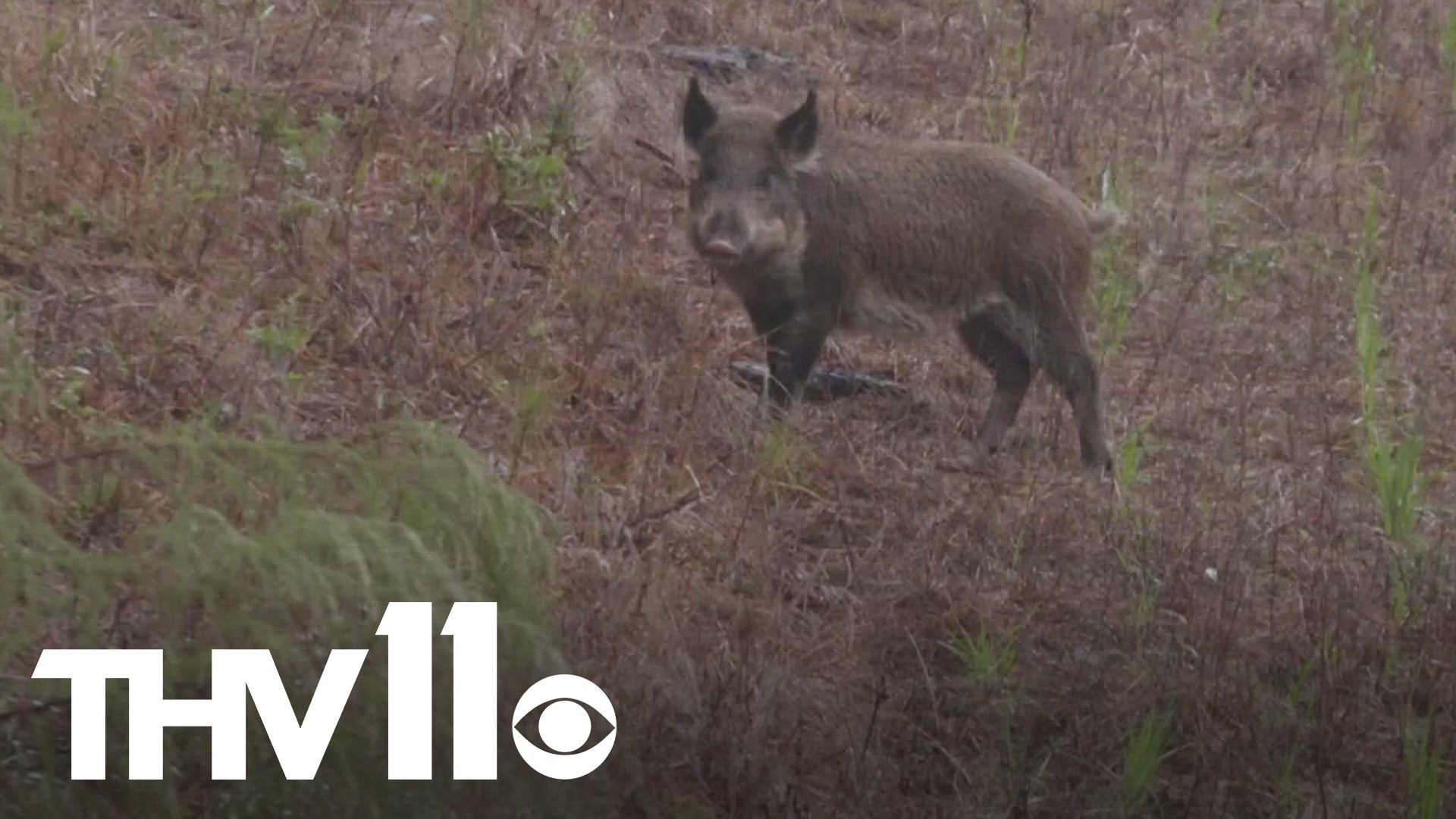ARKANSAS, USA — The job of an Arkansas farmer has never been easy, especially in recent years. Extreme weather, rising diesel costs, and now, something else that Mother Nature created— feral hogs.
While the brunt of the impact has been felt by rural Arkansas, experts are warning that if something doesn’t change, feral hogs could soon be an issue for metropolitan areas.
So, what is a feral hog?
Dr. Vic Ford, an expert at the University of Arkansas’ Department of Agriculture Cooperative Extension Office explained that they are once-domesticated swine that somehow escaped cultivation.
“In Arkansas, people would run the hogs in the woods in the wintertime, then try to catch them at the end of the growing season, which would be in the fall,” Ford explained.
The problem? Not all of the hogs were caught.
Those that evaded capture would spark what experts refer to as the “Feral Swine Bomb”, a reference to just how quickly these aggressive and dirty animals can reproduce.
They can multiply so quickly, and their destructive nature and ability to carry dozens of diseases and pathogens are now impacting more Arkansans.
What was a backwoods novelty has quickly grown into a costly nuisance, and it's one that threatens the way of life for many farmers and ranchers.
Annually, feral hogs are responsible for $40 million in damage in Arkansas, according to the state Department of Agriculture.
Meanwhile, according to the United States Department of Agriculture, the price tag has increased to $1.5 billion nationwide.
Such farmers include Darin Simpson from Arkansas County.
“It's terrible cause we've got probably $250 an acre invested in this crop already. Now we have to go back in the field and rework it, destroy it, and start all over again," Simpson explained.
He isn’t alone. His neighbor Regan Counce has also been a victim of these animals.
Their crops were destroyed even before their seeds begin to sprout. It’s a problem so severe that it threatens the livelihoods of many farmers in the area.
“I would say if we don't get ahead of this, some of these farms and those around here, it's going to be hard to farm them in the next five years,” Counce described.
Much to the relief of farmers like Simpson and Counce, there is a team of experts working to rid the state of this invasive species.
The Arkansas Feral Hog Eradication Task Force was created in 2017, and it is composed of 20 different state and feral agencies and non-government organizations that share one common goal— to terminate this pest.
Leading the task force is J.P. Fairhead, and his mission is to fight this battle by using every tool available. This includes baiting and hunting by helicopters, to using high-tech tools such as thermal-imaging drones.
Fairhead explained that the most effective tool of them all is remote-controlled traps. These traps utilize a series of cameras and cell signal that allows for the trap to be armed when it’s full of swine.
“And these folks can monitor these traps from the comfort of their home and engage that trap when all the pigs that they have determined to be using that site have entered that trap and catch them," he described.
Farmers in the area will agree— these traps are useful.
In fact with the help of these Task Force traps, Counce said over 1,000 hogs have been removed from his farm in the last three years alone.
That's still not enough.
Dr. Ford told us that these hogs reproduce at such a fast rate, in order to maintain a steady population with no growth, 80% of feral hogs must be eliminated.
According to him, this hasn’t yet been achieved, which has ultimately resulted in the continued growth of this nuisance.
In recent years, reports of feral hogs roaming city streets have become more common in neighboring states. This is a real concern for local experts that have been working to prevent further spread.
“As the population increases, human/feral swine interactions could increase and that just further helps drive home the point of need for control and management to keep those interactions down. Because they can be negative, and especially the disease risks are real,” said Fairhead.
Dr. Ford agrees.
“I think as you see things expanded if you have a nice house and what I call the urban-wildland interface, you probably may have feral hogs in your backyard," he added.
Famers who know firsthand the damage these animals can cause have a clear warning for those who live in metropolitan areas.
“I know we're a long way away, and we're kind of out here where nobody else is. But if something doesn't change out here, it's going be at your back door before long, and when it gets there, it's going to be too late,” Counce explained.
Simpson shared the same sentiment.
“Take one of these 400-pound hogs and take him in your backyard. You'll be wanting to get rid of him too," he said.
For more information on how to report if you've come across any feral hogs, please click here.

